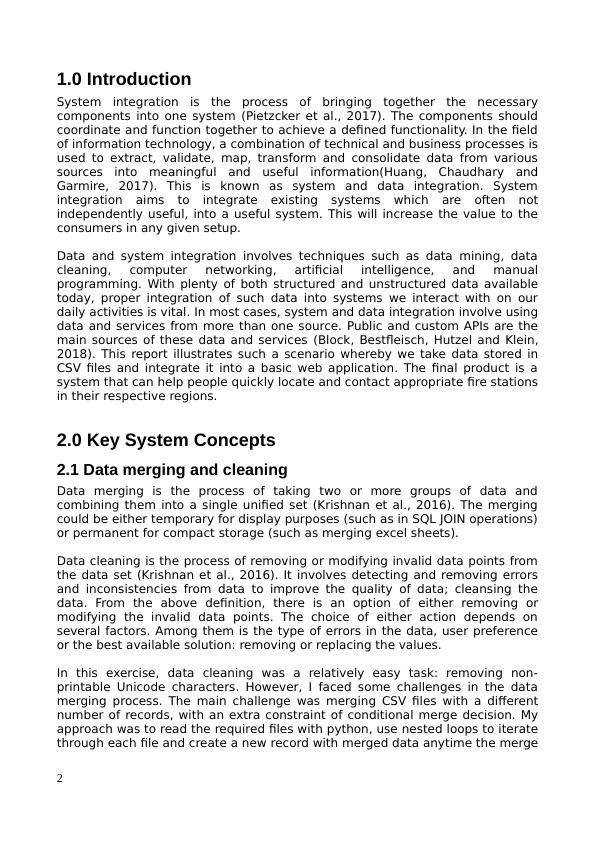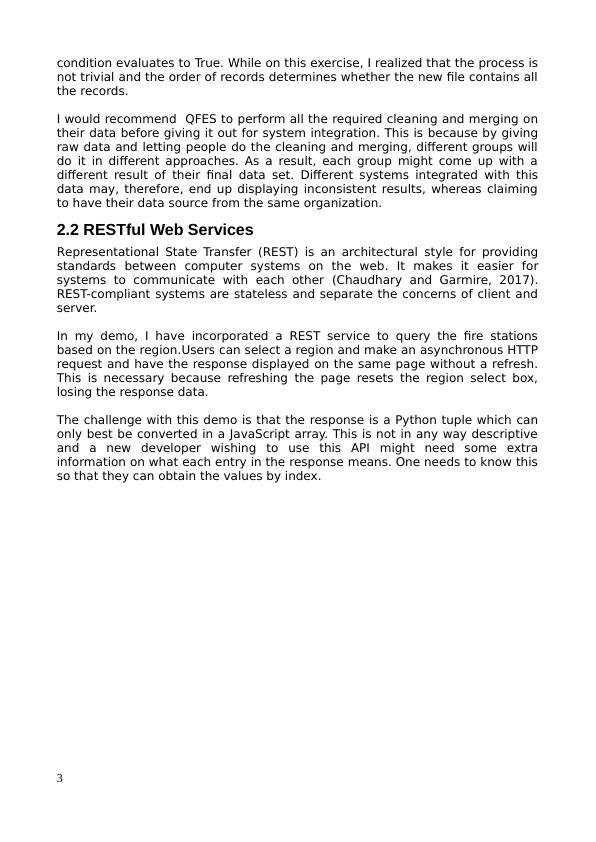Web and Mobile Applications Assignment
Assessment task 2 for the ICT705 Data and System Integration course at ATMC, due on 7th February 2020.
7 Pages1539 Words11 Views
Added on 2022-08-19
Web and Mobile Applications Assignment
Assessment task 2 for the ICT705 Data and System Integration course at ATMC, due on 7th February 2020.
Added on 2022-08-19
ShareRelated Documents
Executive Summary
We often tend to think that each most of the web and mobile applications we
interact wit on our daily basis is a unit block sitting in a cloud server
somewhere. This is not always the case. Most applications today are part of
what is commonly known as service integration. These apps aggregate data
and services from various sources and format it to present a useful app to the
user as a final product. In this paper, we are going to step by step in the
process of moving from desperate CSV files to a Mashup web application. The
application uses a REST API to query fire stations and then Google maps to help
users locate the exact physical location of the stations.
1
We often tend to think that each most of the web and mobile applications we
interact wit on our daily basis is a unit block sitting in a cloud server
somewhere. This is not always the case. Most applications today are part of
what is commonly known as service integration. These apps aggregate data
and services from various sources and format it to present a useful app to the
user as a final product. In this paper, we are going to step by step in the
process of moving from desperate CSV files to a Mashup web application. The
application uses a REST API to query fire stations and then Google maps to help
users locate the exact physical location of the stations.
1

1.0 Introduction
System integration is the process of bringing together the necessary
components into one system (Pietzcker et al., 2017). The components should
coordinate and function together to achieve a defined functionality. In the field
of information technology, a combination of technical and business processes is
used to extract, validate, map, transform and consolidate data from various
sources into meaningful and useful information(Huang, Chaudhary and
Garmire, 2017). This is known as system and data integration. System
integration aims to integrate existing systems which are often not
independently useful, into a useful system. This will increase the value to the
consumers in any given setup.
Data and system integration involves techniques such as data mining, data
cleaning, computer networking, artificial intelligence, and manual
programming. With plenty of both structured and unstructured data available
today, proper integration of such data into systems we interact with on our
daily activities is vital. In most cases, system and data integration involve using
data and services from more than one source. Public and custom APIs are the
main sources of these data and services (Block, Bestfleisch, Hutzel and Klein,
2018). This report illustrates such a scenario whereby we take data stored in
CSV files and integrate it into a basic web application. The final product is a
system that can help people quickly locate and contact appropriate fire stations
in their respective regions.
2.0 Key System Concepts
2.1 Data merging and cleaning
Data merging is the process of taking two or more groups of data and
combining them into a single unified set (Krishnan et al., 2016). The merging
could be either temporary for display purposes (such as in SQL JOIN operations)
or permanent for compact storage (such as merging excel sheets).
Data cleaning is the process of removing or modifying invalid data points from
the data set (Krishnan et al., 2016). It involves detecting and removing errors
and inconsistencies from data to improve the quality of data; cleansing the
data. From the above definition, there is an option of either removing or
modifying the invalid data points. The choice of either action depends on
several factors. Among them is the type of errors in the data, user preference
or the best available solution: removing or replacing the values.
In this exercise, data cleaning was a relatively easy task: removing non-
printable Unicode characters. However, I faced some challenges in the data
merging process. The main challenge was merging CSV files with a different
number of records, with an extra constraint of conditional merge decision. My
approach was to read the required files with python, use nested loops to iterate
through each file and create a new record with merged data anytime the merge
2
System integration is the process of bringing together the necessary
components into one system (Pietzcker et al., 2017). The components should
coordinate and function together to achieve a defined functionality. In the field
of information technology, a combination of technical and business processes is
used to extract, validate, map, transform and consolidate data from various
sources into meaningful and useful information(Huang, Chaudhary and
Garmire, 2017). This is known as system and data integration. System
integration aims to integrate existing systems which are often not
independently useful, into a useful system. This will increase the value to the
consumers in any given setup.
Data and system integration involves techniques such as data mining, data
cleaning, computer networking, artificial intelligence, and manual
programming. With plenty of both structured and unstructured data available
today, proper integration of such data into systems we interact with on our
daily activities is vital. In most cases, system and data integration involve using
data and services from more than one source. Public and custom APIs are the
main sources of these data and services (Block, Bestfleisch, Hutzel and Klein,
2018). This report illustrates such a scenario whereby we take data stored in
CSV files and integrate it into a basic web application. The final product is a
system that can help people quickly locate and contact appropriate fire stations
in their respective regions.
2.0 Key System Concepts
2.1 Data merging and cleaning
Data merging is the process of taking two or more groups of data and
combining them into a single unified set (Krishnan et al., 2016). The merging
could be either temporary for display purposes (such as in SQL JOIN operations)
or permanent for compact storage (such as merging excel sheets).
Data cleaning is the process of removing or modifying invalid data points from
the data set (Krishnan et al., 2016). It involves detecting and removing errors
and inconsistencies from data to improve the quality of data; cleansing the
data. From the above definition, there is an option of either removing or
modifying the invalid data points. The choice of either action depends on
several factors. Among them is the type of errors in the data, user preference
or the best available solution: removing or replacing the values.
In this exercise, data cleaning was a relatively easy task: removing non-
printable Unicode characters. However, I faced some challenges in the data
merging process. The main challenge was merging CSV files with a different
number of records, with an extra constraint of conditional merge decision. My
approach was to read the required files with python, use nested loops to iterate
through each file and create a new record with merged data anytime the merge
2

condition evaluates to True. While on this exercise, I realized that the process is
not trivial and the order of records determines whether the new file contains all
the records.
I would recommend QFES to perform all the required cleaning and merging on
their data before giving it out for system integration. This is because by giving
raw data and letting people do the cleaning and merging, different groups will
do it in different approaches. As a result, each group might come up with a
different result of their final data set. Different systems integrated with this
data may, therefore, end up displaying inconsistent results, whereas claiming
to have their data source from the same organization.
2.2 RESTful Web Services
Representational State Transfer (REST) is an architectural style for providing
standards between computer systems on the web. It makes it easier for
systems to communicate with each other (Chaudhary and Garmire, 2017).
REST-compliant systems are stateless and separate the concerns of client and
server.
In my demo, I have incorporated a REST service to query the fire stations
based on the region.Users can select a region and make an asynchronous HTTP
request and have the response displayed on the same page without a refresh.
This is necessary because refreshing the page resets the region select box,
losing the response data.
The challenge with this demo is that the response is a Python tuple which can
only best be converted in a JavaScript array. This is not in any way descriptive
and a new developer wishing to use this API might need some extra
information on what each entry in the response means. One needs to know this
so that they can obtain the values by index.
3
not trivial and the order of records determines whether the new file contains all
the records.
I would recommend QFES to perform all the required cleaning and merging on
their data before giving it out for system integration. This is because by giving
raw data and letting people do the cleaning and merging, different groups will
do it in different approaches. As a result, each group might come up with a
different result of their final data set. Different systems integrated with this
data may, therefore, end up displaying inconsistent results, whereas claiming
to have their data source from the same organization.
2.2 RESTful Web Services
Representational State Transfer (REST) is an architectural style for providing
standards between computer systems on the web. It makes it easier for
systems to communicate with each other (Chaudhary and Garmire, 2017).
REST-compliant systems are stateless and separate the concerns of client and
server.
In my demo, I have incorporated a REST service to query the fire stations
based on the region.Users can select a region and make an asynchronous HTTP
request and have the response displayed on the same page without a refresh.
This is necessary because refreshing the page resets the region select box,
losing the response data.
The challenge with this demo is that the response is a Python tuple which can
only best be converted in a JavaScript array. This is not in any way descriptive
and a new developer wishing to use this API might need some extra
information on what each entry in the response means. One needs to know this
so that they can obtain the values by index.
3

End of preview
Want to access all the pages? Upload your documents or become a member.
Related Documents
Assignment on Web and Mobile Applicationslg...
|16
|3426
|14
ICT705 Data and System Integrationlg...
|17
|2694
|340
Data and System Integration for Deskliblg...
|12
|1561
|446
Data System and Integration: A Study on Data Cleaning, Merging, RESTful Web Services, and Mashupslg...
|12
|1694
|296
Data and System Integration: Key Components and Demo Running Instructionslg...
|11
|1537
|137
Data and System Integration for Clinic Locator Applg...
|14
|1682
|82
